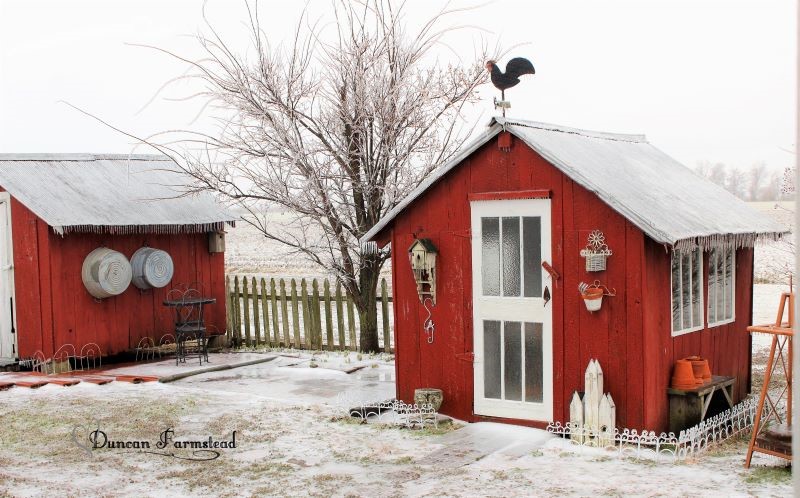"On the southwest side of the small community of Lone Oak sits a house in great disrepair, a prime example of so many tenements common to the early farming era of the county. This house may soon meet a similar fate. Many times, as we drove past it over the years, I've commented that I "need to get some photos and measurements before it disappears!" In the winter, it's too muddy and cold. In the summer, it's too hot--and "snakey"--and "grown up." This spring of 2011 seemed to be the right time, as I noticed that more of the house had fallen and that the windows and doors had disappeared. With permission, a camera, a tape measure, a sketch pad, and a pencil in hand, we braved the already growing "jungle," as well as the active wasp and bee population, and headed for the old tenant house." (DUNCAN FARMSTEAD WEBSITE)

It is hard to believe all these years have passed, and yet, the old house was still standing the last time I drove through Lone Oak. . .although in worse shape than ten years ago. . .
I ran across some photos I don't believe I shared before and decided to start a series of posts on a few of the tenant, bungalow, cottage, and farmhouses that were once great in number throughout the area. I have touched upon them at the Duncan Farmstead website and a few at the Dell, Ar blog (which no longer is available for view to the public). These old relics have all but disappeared now, many since we moved back to the farm in 2005. Farm fields dominate today. The population of Mississippi County has greatly diminished as more and more people move away. But as along as the stories are still being told, the past will live on.
This little Craftsman bungalow sits at Lone Oak on the south side of East State Highway 239, next to the two story farmhouse of B. B. Hodge. It remains in the Hodge family, I believe.

"Lone Oak got it’s name from a single, very tall oak tree that was a landmark for local hunters. It was so tall that during the 1882 flood, the only thing that could be seen above the water was that one lone oak. It was also the only oak tree around during dry periods. Other trees included sycamore, gum, cypress, and other general woods. The story goes that Sam Hector actually gave the community its name in honor of the oak landmark.
One of the stories that’s been handed down concerns that oak tree and Sam Hector. He was traveling down the Pemiscot Bayou in a boat one day and looked up at the big oak tree. There was a bear hugging the tree. Sam took out his rifle and shot the bear and killed him.
At the beginning of the 20th century, the Lone Oak was found south of the Lone Oak school at the home of B. B. Hodge." (Dell, AR blog post 2012)

My favorite room is the kitchen with its metal cabinets and old porcelain sink, which I doubt were original to the house but added perhaps during the 1950s or so. This was much better than most tenant houses and cost more than the simple wood shelves and few cabinets that were more common in the tenements of this farm. I can imagine the daily activity in this room--the bean pot on the stove, the vegetables and canning going on daily in the summertime, the constant slamming of the backdoor as the family comes and goes, living as much outside with the land as inside. It was long days of work for all, but it was also a time of family and friends bonding in the tasks at hand. . .
 |
| Kitchen; Bedroom through door |
 |
Layout--BB Hodge Craftsman Bungalow
Top Lft-Living Room; Top Rt-Bedroom; Bathroom Behind Bedroom
Back Lft-Kitchen; Back Rt-Bedroom |
My very rough layout is a little confusing. The front of the house that faces the road are the top rooms.
 |
| Kitchen |
This was a very bright kitchen in its day. . .
 |
| Kitchen |
 |
| Kitchen |
I can imagine a big family table sitting in this corner with its many windows looking out over the fields.
The walls are of sheetrock. . .Please note that even though the walls in every room are deteriorating, often the holes have been made by treasure hunters looking for money or valuables that were sometimes hidden in the walls or ceiling. In many abandoned houses I have visited, any fabric covered couches or chairs still present were also cut into shreds.
 |
| Living Room |
Over the years in the living room, it is obvious that keeping the cold winter winds at bay was attempted by many generations of families. Those clapboards were not sealed in any way. Newspaper and cardboard were pasted and tacked in layers on the inside of the clapboard originally and walls of sheetrock added. Then sometime, maybe in the 1960s, insulation and paneling were applied.
 |
| Living Room |
 |
| Bedroom; Bathroom through door |
In this back bedroom, more paneling once covered the sheetrock walls. . .
 |
| Bathroom |
There was no bathroom in the original house. Space taken from one of the bedrooms added an inside bath in later years. Plumbing was run from the kitchen.
This house was once a cozy little bungalow. The numerous windows would have made it quite bright inside. There were two porches, one front and one back, that helped to extend the living space and offered cooler breezes in the hot summers. Cottages such as these have always been dear to my heart, probably because I have known so many wonderful people who lived in them.
COMING SOON: PRESENT DAY PHOTOS

.JPG)


.JPG)
.JPG)
.JPG)


























